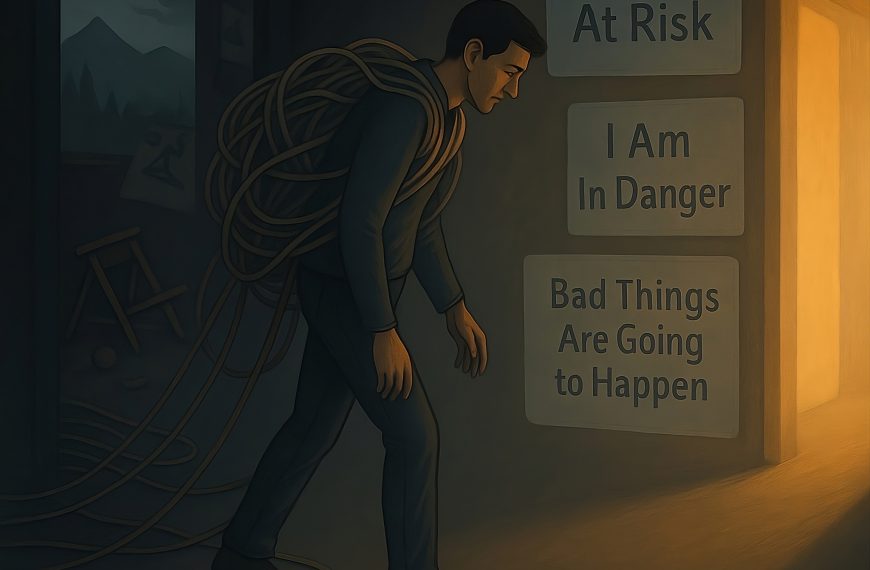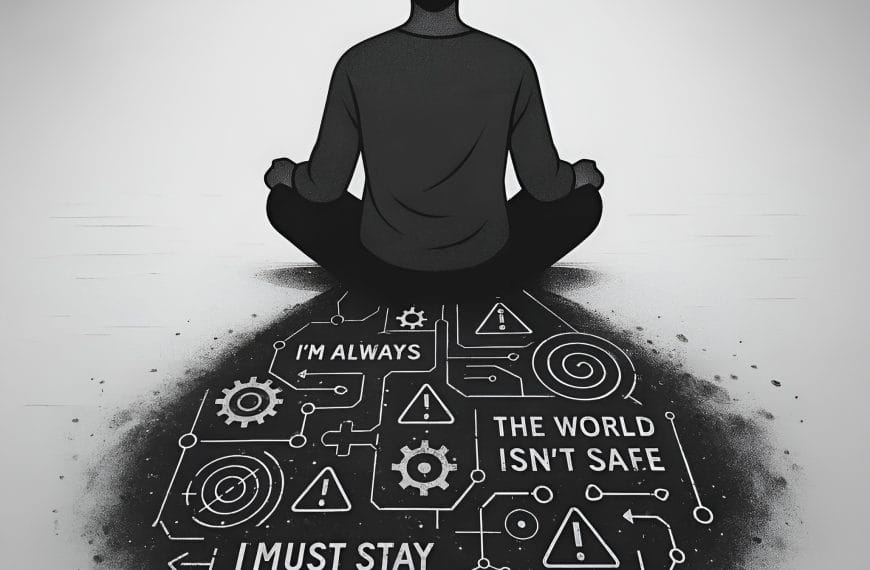Introduction
Life in Calgary has its share of challenges: long winters, demanding work environments, and the high-paced energy of a growing city. But for many people, the weight they carry isn’t just about today’s pressures — it’s the unseen script running underneath.
At ShiftGrit, we call those scripts Limiting Beliefs. They aren’t simply pessimistic thoughts. They’re deep, identity-level convictions formed early in life, often through Non-Nurturing Elements™ like criticism, neglect, or inconsistency. Over time, these beliefs start acting like the rules of a game you didn’t choose — rules that keep anxiety patterns alive long after the original circumstances are gone.
Understanding what Limiting Beliefs are, how they form, and how they tie into anxiety is the first step to unravelling them.
What Are Limiting Beliefs?
Limiting Beliefs are not conscious affirmations like “I’m bad at math” or “I’ll never be good enough.” They’re core convictions that sink below awareness and shape how your brain, body, and emotions respond to the world.
Examples include:
These aren’t surface-level thoughts. They’re identity-level conclusions your brain drew from repeated early experiences that didn’t meet your needs. Once formed, they act like filters. Everything you encounter is interpreted through them, whether you realize it or not.
How They Form: The Role of Non-Nurturing Elements™
When a child experiences repeated Non-Nurturing Elements™ (NNEs) — like unpredictable caregiving, chronic criticism, or bullying — the brain adapts. It creates beliefs designed to help them survive in that environment.
For example:
- A child growing up in a chaotic household might form the belief I Am Not in Control.
- A child constantly criticized might internalize I Am a Disappointment.
- A child excluded by peers might form I Am Unwelcome.
While these beliefs may have been protective at the time, they linger into adulthood — even when they no longer fit the present-day reality.
How Limiting Beliefs Fuel Anxiety
Anxiety is often less about the stressors of today and more about yesterday’s rules still running the show.
Here’s the loop:
- Non-Nurturing Elements™ create the belief (I Am Vulnerable).
- That belief drives a Dysfunctional Need™ (e.g., “I must prepare for every possible outcome”).
- Meeting that need creates internal strain — the Pressure Cooker effect.
- Eventually, the pressure releases through an Opt-Out Behaviour (avoidance, procrastination, withdrawal).
- The temporary relief reinforces the belief, keeping the loop alive.
The result: anxiety that feels “hardwired,” even though it’s actually a conditioned response.
While anxiety often feels like it comes out of nowhere, research confirms that it is deeply tied to how the brain learns and maintains patterns. According to the American Psychological Association, anxiety disorders frequently involve thought systems that exaggerate perceived threats and reinforce avoidance behaviours. This mirrors how Limiting Beliefs work — creating hidden rules that quietly shape responses long after the original circumstances are gone.
Why Therapy Can Feel Hard at First
Here’s a truth that surprises people: starting therapy that actually changes patterns can sometimes feel harder before it feels easier.
Think of it like beginning a new exercise routine. If you’ve been sitting for months and suddenly join a demanding yoga or fitness program, the first few sessions don’t feel great. You’re sore, uncomfortable, and sometimes you even wonder if you’re making things worse. But over time, those growing pains become strength and stamina.
Therapy works much the same way. When we target Limiting Beliefs, we often revisit the triggers that encoded them. That can feel uncomfortable in the moment, because it briefly brushes against the very thing you’ve spent years avoiding. But it’s not a setback — it’s a sign that your Walnut Brain is being updated with new, present-day information.
At ShiftGrit, we call this “truth over comfort.” It takes grit to step into the process, but the reward is lasting change that doesn’t depend on constantly remembering strategies.
Glossary Connections
- Limiting Beliefs → the hidden rules at the identity level.
- Non-Nurturing Elements™ → early experiences that shaped them.
- Dysfunctional Need™ → coping strategies built on top of those beliefs.
- Pressure Cooker → the internal strain of constantly managing the need.
- Opt-Out Behaviour → the short-term escape that resets the loop.
- Walnut Brain → the primitive threat-detection system that keeps running these old programs.
Each concept links together, showing how anxiety is not random but a patterned response.
Limiting Beliefs in Calgary Life
While the beliefs themselves come from early experiences, life in Calgary can amplify them:
- High-pressure industries like energy, tech, and finance reinforce “I Am Falling Behind” or “I Will Fail.”
- Economic swings in housing and employment can intensify “I Am Not in Control” or “I Am Unsafe.”
- Seasonal isolation from long winters can magnify “I Am Alone” or “I Am Unwelcome.”
On top of this, Calgary’s culture of high achievement — from demanding careers to competitive parenting to “keeping up” socially — often stirs up comparisons that trigger Limiting Beliefs like “I Am Not Good Enough.” Even something as ordinary as a long commute on Deerfoot or Crowchild, stuck in traffic you can’t control, can reinforce a belief like “I Am Powerless.”
The city itself doesn’t cause anxiety — but it often activates the dormant beliefs already in place.
The ShiftGrit Approach: Identity-Level Therapy
At ShiftGrit Calgary, we specialize in addressing anxiety at the root: the Limiting Beliefs driving it.
Our process includes:
- Pattern Mapping → tracing anxiety triggers back to the exact beliefs created by early Non-Nurturing Elements™.
- Reconditioning Protocol → a five-step imaginal exposure method that updates the Walnut Brain with present-day safety cues.
- Integration → once reconditioned, the belief loses its grip, reducing automatic anxiety responses.
This is more than teaching coping strategies. It’s about changing the belief itself — the identity-level driver of the pattern.


Practical Steps You Can Take Now
If you’re wondering whether Limiting Beliefs play a role in your anxiety, here are some first steps:
- Track recurring triggers → notice when anxiety spikes and ask, “What belief does this connect to?” For instance, a client once realized their Sunday evening dread wasn’t about Monday’s workload but about the belief “I Am Not in Control,” triggered by the shift from weekend freedom to work obligations.
- Reflect on early patterns → think about repeated situations that left you feeling unsafe, powerless, or not enough. Someone excluded as a child may notice that adult social situations still reactivate “I Am Unwelcome.”
- Learn the Walnut Brain → understanding how it works explains why logic alone doesn’t shut off anxiety. Knowing that your brain isn’t “broken,” just running an outdated survival program, can be empowering.
- Observe coping loops → are you overcompensating to meet a Dysfunctional Need™ like control, perfection, or reassurance? Seeing the loop in action is the first step to stepping out of it.
Even simple awareness can start breaking the automatic loop.
Explore Further
📖 ShiftGrit Glossary Entry → Limiting Beliefs
🧠 Pattern Library → Core Beliefs & Triggers
🔄 Learn More → Reconditioning Protocol
Calgary Anxiety Therapy — Addressing Limiting Beliefs at the Source
Limiting Beliefs don’t just sit quietly — they quietly run the show until challenged. Left unchecked, they fuel the very loops that keep anxiety alive.
At ShiftGrit Calgary, we work with clients to identify and recondition these beliefs using our structured, identity-level approach. Whether it’s I Am Not in Control, or I Am a Failure, our process maps the pattern and rewires it at its core.
When the belief changes, the pattern changes — and so does your life.
👉 Explore Calgary Anxiety Therapy → Book an Intake Today
More Resources from ShiftGrit Psychology Calgary
- Our Calgary Psychology Office
- Identity-Level Therapy: How We Rewire Limiting Beliefs
- Explore the Pattern Library
- Core Belief: I Am Not Good Enough
- Core Belief: I Am A Failure
- Self-Sabotage Therapy in Calgary
- What Emotional Dysregulation Actually Is
- Blog: Why Willpower Fails — And What to Do Instead






















